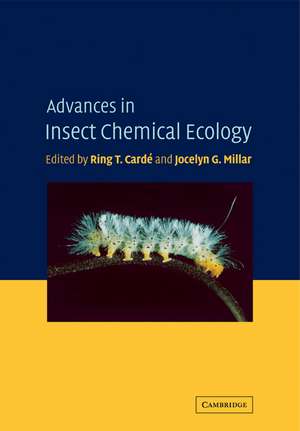Advances in Insect Chemical Ecology
Editat de Ring T. Cardé, Jocelyn G. Millaren Limba Engleză Paperback – 27 apr 2011
| Toate formatele și edițiile | Preț | Express |
|---|---|---|
| Paperback (1) | 430.44 lei 6-8 săpt. | |
| Cambridge University Press – 27 apr 2011 | 430.44 lei 6-8 săpt. | |
| Hardback (1) | 873.59 lei 6-8 săpt. | |
| Cambridge University Press – 20 iun 2004 | 873.59 lei 6-8 săpt. |
Preț: 430.44 lei
Nou
Puncte Express: 646
Preț estimativ în valută:
82.37€ • 85.89$ • 68.46£
82.37€ • 85.89$ • 68.46£
Carte tipărită la comandă
Livrare economică 21 martie-04 aprilie
Preluare comenzi: 021 569.72.76
Specificații
ISBN-13: 9780521188937
ISBN-10: 0521188938
Pagini: 352
Dimensiuni: 170 x 244 x 19 mm
Greutate: 0.56 kg
Editura: Cambridge University Press
Colecția Cambridge University Press
Locul publicării:Cambridge, United Kingdom
ISBN-10: 0521188938
Pagini: 352
Dimensiuni: 170 x 244 x 19 mm
Greutate: 0.56 kg
Editura: Cambridge University Press
Colecția Cambridge University Press
Locul publicării:Cambridge, United Kingdom
Cuprins
Preface; 1. Phytochemical diversity of insect defenses in tropical and temperate plant families John T. Arason, Gabriel Guillet and Tony Durst; 2. Recruitment of predators and parasitoids by herbivore-injured plants Ted C. J. Turlings and Felix Wäckers; 3. Chemical ecology of astigmatid mites Yasumasa Kuwahara; 4. Semiochemistry of spiders Stefan Schulz; 5. Why do flowers smell? The chemical ecology of fragrance-driven pollination Robert A. Raguso; 6. Sex pheromones of cockroaches César Gemeno and Coby Schal; 7. A quest for alkaloids: curious relationship between tiger moths and plants containing pyrrolizidine alkaloids William E. Conner and Susan J. Weller; 8. Structure of the pheromone communication channel in moths Ring T. Cardé and Kenneth F. Haynes; Index.
Recenzii
Review of the hardback: 'This volume presents an excellent collection of reviews that should be useful to those working within and outside this study area.' Bulletin of the World Health Organization
Review of the hardback: 'The wide scope, systematic approach and technical language all make this an excellent reference text.' Biologist
Review of the hardback: '… an interesting book, summarizing not only a great amount of detailed knowledge, but addressing also general evolutionary issues such as the role of pheromones for speciation processes. … provides a fascinating complexity of plant-insect and insect-insect interactions and communication that enthrals even the experienced reader and thus encourages every effort to preserve the future of these interactions and their further evolution. … provides fascinating topics for the generally interested reader and student, as well as detailed accounts for professionals working in specific areas. Thus, I recommend this book to all persons aiming to 'look behind the curtain' of plant-insect interactions as well as interactions between insects - these readers will be impressed.' Journal of Insect Conservation
' … informative and detailed …' American Entomologist
Review of the hardback: 'The wide scope, systematic approach and technical language all make this an excellent reference text.' Biologist
Review of the hardback: '… an interesting book, summarizing not only a great amount of detailed knowledge, but addressing also general evolutionary issues such as the role of pheromones for speciation processes. … provides a fascinating complexity of plant-insect and insect-insect interactions and communication that enthrals even the experienced reader and thus encourages every effort to preserve the future of these interactions and their further evolution. … provides fascinating topics for the generally interested reader and student, as well as detailed accounts for professionals working in specific areas. Thus, I recommend this book to all persons aiming to 'look behind the curtain' of plant-insect interactions as well as interactions between insects - these readers will be impressed.' Journal of Insect Conservation
' … informative and detailed …' American Entomologist
Descriere
Originally published in 2004, these eight reviews reveal how insects use chemical signals to communicate and interact ecologically.












